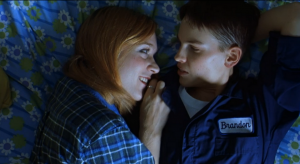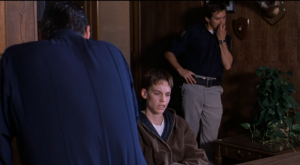30 Boys Don’t Cry (1999)
A Brave and Unusual Film: Boys Don’t Cry (1999)
By Jessica Lee
Content Warning: Contains discussion of sexual assault and violence
Thinking about a movie representing difference, power, and discrimination, the first movie that came to mind was Boys Don’t Cry by Kimberly Pierce. I had seen this movie a few years back, however this time I am determined to analyze the importance of transgender/sex characters in cinema. Boys Don’t Cry is a movie about a transgender male, Brandon Teena, who longs and searches for a girl to love. He finds himself meeting this close group of friends who take Brandon to their hometown, Falls City Nebraska, and befriend him. The movie came out in 1999 when identifying as transgender was not very accepted or common, and its portrayal in films was more as a subject of humor such as Chaplin in Carmen or Lemon and Curtis in Some Like it Hot (French, 2000). Therefore having a serious movie including transgender or cross-dressing characters was, as movie reviewer Philip French described Pierce’s movie, “brave and unusual” (French, 2000).
The main setting of the movie is in Falls City Nebraska and all of the main characters are white and straight, considering that Brandon identifies as male but with the female sex organs he was born with. Interestingly enough, there was some backlash due to the casting of Brandon being a female, Hillary Swank, instead of casting a queer actor. But throughout the filmmaking process, Hillary made sure to keep the image of herself as her character, meaning she tried to make the rest of the cast and crew continually see that she was a male to make her character more believable (King, 2019). The making of this movie contains examples of difference between gender and sex, discrimination that Brandon faces, and power near the end of the movie by law enforcement.

Because of a lack of other LGBT members in the characters of the movie, it shows that difference is a strong message portrayed in the story. As soon as there was a hint that Brandon was female, John Tom and Candace look for other evidence that he was a she. This led to a whole investigation between the group of friends, trying to figure out “what” Brandon was. However, Brandon tries his hardest to act like, dress like, and look like a male to prevent being seen as different. But certain scenes including one toward the beginning of the movie begins with John saying “Dang you have tiny hands” (tiny hands compared to other men) are one of the clues leading to the discovery of Brandon’s secret. These found differences add up to create a strong case for the friends to turn into discrimination.
Before talking about gender discrimination, there is an important detail from the beginning of the movie that represents discrimination based on class. Brandon found out that the medical cost for the sex-change surgery he needed is extremely expensive. (Trying to find a definite total cost of the surgeries from 1990’s was inconclusive. However, today in 2021, depending on the company, some health insurance companies may cover some part of the surgical procedures but either way, the cost was still high and coverage was indeterminable). In the movie, this expense paints a picture that only the wealthy can get away with transsexualism and can buy their way out of problems, while on the other hand, lower-class people have to suffer once again. Brandon for example, has to keep struggling with his gender dysphoria because he cannot have the sex-change surgery. Returning to the gender discrimination discussed within the movie, as soon as the friend group found out Brandon’s secret, the guys, John and Tom, force Brandon into the bathroom and they start ripping Brandon’s clothes off. They humiliate him through physical force just to prove that he is different, and continue to physically harass Brandon with punches and shoving him into the wall while Brandon’s girlfriend Lana pounds on the door and begs them to stop. During this scene, Lana is forced by John to look at Brandon after they had stripped him to show to her that she is in love with a ‘girl’ but Lana tries to pull away. Discrimination against Brandon doesn’t stop there, for the police were called and Brandon was again discriminated by power.
Power expressed in this movie has a main example at the end of the movie. After Brandon was raped by John and Tom, Brandon had gone to the police, on the advice of his girlfriend Lana. While the sheriff interviewed Brandon, he asked offensive questions basically making Brandon relive his horrifying experience. Brandon would say no, John and Tom didn’t touch him, but the sheriff persisted. The power shown by the police in this scene is that the sheriff’s questions could not have been more demeaning to Brandon’s gender identity (“didn’t that get your attention somehow, that he wouldn’t put his hand in your pants and play with you a little bit?”(1:25:40)). Flashbacks of the rape continue throughout this interrigation switching from the shot of him and the sheriff to him being attacked by John and Tom. The sheriff made Brandon admit that he has a vagina, and he justified this “re-rape” as just trying to help Brandon because he needed to know everything that was going on. In that scene, the cinematography also provided an image of power, for the sheriff was sitting higher than Brandon, on a desk, while Brandon sat in the chair. The camera angles created the image that the sheriff was more powerful because of the size of his body and how he towers over Brandon, intimidating him.

I chose this text out of so many other examples, movies, TV shows because I believe that this problem of discrimination of the queer community is ongoing. Yes, there is a pride month each year, the legalization of gay marriage in some states, and some health insurance companies may cover a sex change. But the fact that Brandon Teena was beaten, raped, and murdered in a small town in 1993 because he was different still haunts me. The media coverage of his death was highly gendered, for they continued to refer to him as she, such as a headline: “Cross-Dresser Killed Two Weeks After Town Learned Her True Identity” (DeMilio, 2014) or making it seem like Brandon gave the boys the reason to murder him, like the sheriff in the movie turning Brandon from a victim to the accused. Some of those newspaper headlines read “Death of a deceiver” or “Deadly Deception: Teena Brandon’s Double Life May Have Led to a Triple Murder”(DeMilio, 2014). The world did not know how to describe Brandon Teena in a way that respected him, but Kimberly Pierce strove to correctly represent and respect the life of Brandon Teena in her movie Boys Don’t Cry as much as possible. In their outstanding analysis of multiple representations of trans cinema, author Wibke Straube discusses cultural studies scholar Judith Jack Halberstam’s description of Boys Don’t Cry as a film modeling ‘embedded looking’, “the possibility to observe the scenery through the trans character’s perspective” (Straube, 2014 p.152); which is exactly the perspective Pierce wanted her film to be in: To show the viewers the hardships Brandon (and other transgenders) endured from his position, in hopes of leading the audience to an understanding of how tragically his life ended.
This film is personal to me, for I am part of the LGBTQ+ community and feel strongly to raise awareness of the discrimination faced in this community as well as others. I highly recommend Boys Don’t Cry because of the powerful determination of love, and how the portrayal of a transgender male played by Hillary Swank is fairly accurate to the fears and struggles that transgender individuals endure. It is an important film in the history of queer cinema that is based on a true story of violence and very powerful perspective of the life, experiences, and struggles of a transgender male.
REFERENCES
DeMilio, Kara. WGS.640 Screen Women: Body Narratives in Popular American Film. Spring 2014. Massachusetts Institute of Technology: MIT OpenCouseWare, https://ocw.mit.edu/. License: Creative Commons BY-NC-SA. www.ocw.mit.edu/courses/womens-and-gender-studies/wgs-640-screen-women-body-narratives-in-popular-american-film-spring-2014/assignments/MITWGS_640S14_BDC_ppr_KD.pdf
French, Philip. Boys Don’t Cry. The Observer. April 9, 2000. www.theguardian.com/film/News_Story/Critic_Review/Observer_review/0,4267,157822,00.html
King, Susan. “Hilary Swank Reflects on ‘Boys Don’t Cry’: “it’s Such an Important Story for People to Know”.” The Hollywood Reporter. The Hollywood Reporter, 25 Oct. 2019. Web. 29 Aug. 2021. www.hollywoodreporter.com/movies/movie-news/hilary-swank-reflects-boys-dont-cry-an-important-story-people-know-1249896/
Straube, Wibke. Trans Cinema and Its Exit Scapes: A Transfeminist Reading of Utopian Sensibility and Gender Dissidence in Contemporary Film. 2014. Linkoping University, PhD dissertation. liu.diva-portal.org/smash/get/diva2:742465/FULLTEXT02.pdf

